Accessing general information concerning the impact of pesticides on human health.
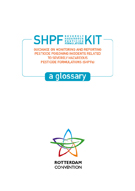 |
Glossary
The glossary provided here defines terms that are found within this SHPF kit.
Some additional, common terms are also included for the user’s information |
1. Developing health monitoring systems; manuals and guides
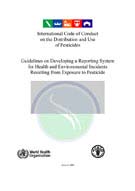 |
Guidelines on Developing a Reporting System for Health and Environmental Incidents Resulting from Exposure to Pesticides
(FAO, WHO, 2009)
Guidelines produced under the International Code of Conduct on the Distribution and Use of Pesticides. The purpose of this guideline is to assist governments in taking the first step in the development and establishment of a basic reporting program for pesticide incidents, which have been defined here as situations where pesticide exposure has resulted in a health or environmental problem. The information collected can be used to minimize adverse impacts on human health and the environment through appropriate pesticide risk reduction measures. Information on incidents should be provided to pesticide regulatory authorities as a means of strengthening national decision making on pesticides. |
 |
Pesticide-Related Illness and Injury Surveillance:
A How-To Guide For State-Based Programs
(NIOSH Publication No. 2006-102)
This comprehensive manual provides information on how to develop and maintain surveillance programs for acute and sub-acute health effects from pesticide exposure. It was developed for U.S. State health departments with planned or established pesticide poisoning surveillance programs.
NIOSH is the U.S. federal agency responsible for conducting research and making recommendations for the prevention of work-related injury and illness. |
2. Case studies and field tools
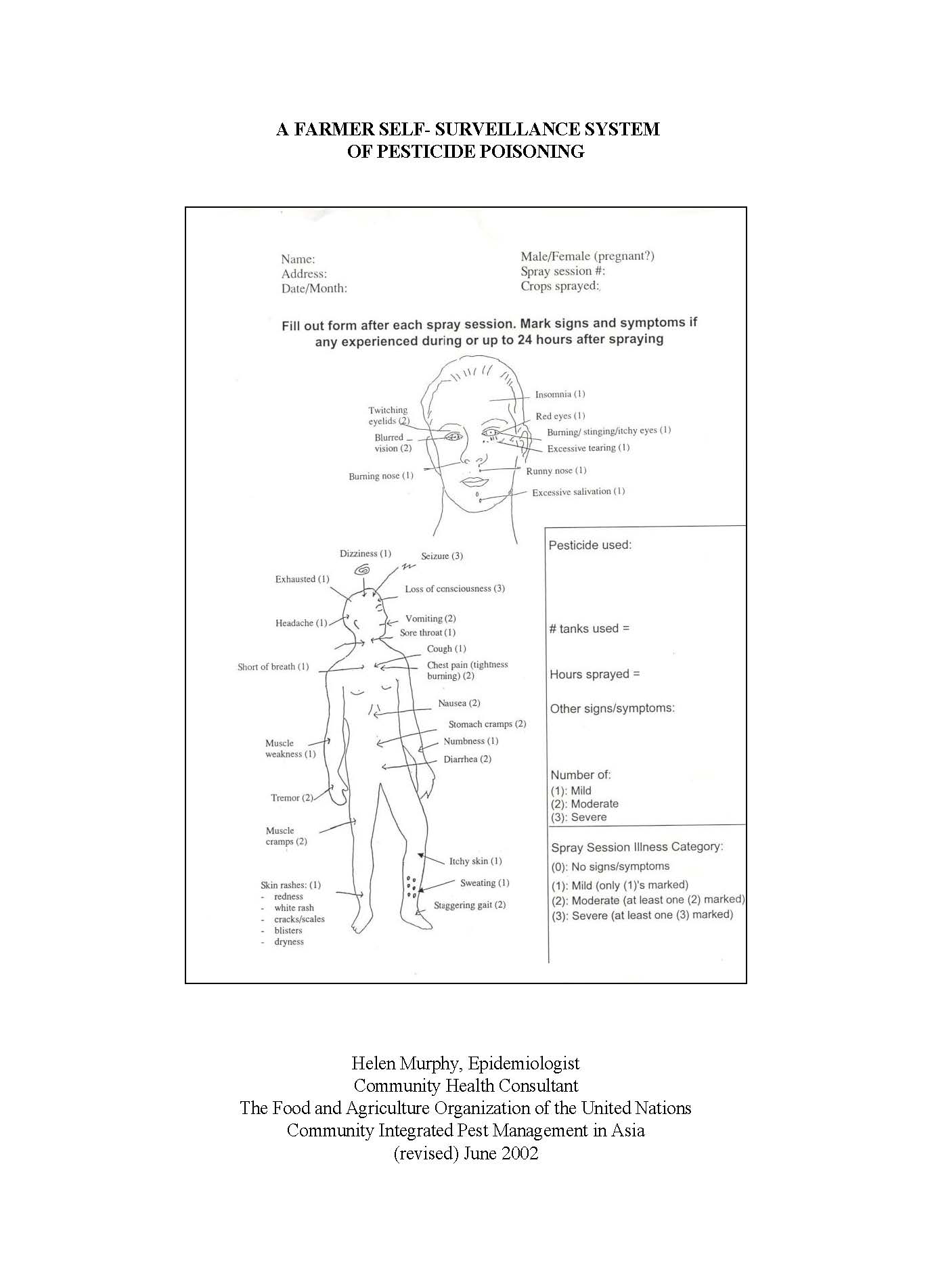 |
A farmer self-surveillance system of pesticide poisoning
(Helen Murphy, Community Integrated Pest Management in Asia, FAO June 2002)
A tool developed by the Integrated Pest Management Programme for Asia (FAO/IPM) to prepare simple means for farmers to self-report signs and symptoms of pesticide poisoning after each spray session. Trained community members collect the forms weekly. They then summarize, graph, and present back to the participating community the data for discussion on a monthly basis. A local physician attends each of these meetings and adds any pesticide poisoning cases seen in the local clinic from the proceeding the month. |
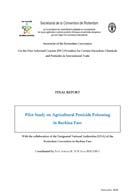 |
Pilot study on agricultural pesticide poisoning in Burkina Faso
(Toe Adama, Final report, FAO, 2010)
A pilot study sponsored by the Secretariat of the Rotterdam Convention. The report provides details of the methodology used, including copies of survey tools, as well as an analysis of the results of surveys conducted among various stakeholders including farmers, health officers and retailers.
|
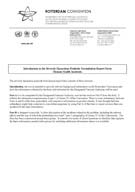 |
Pesticide incident report forms
(Secretariat of the Rotterdam Convention, 2004)
Standard incident report forms for human health incidents and environmental incidents involving hazardous pesticide formulations have been developed to assist with the reporting of these incidents.
|
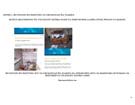 |
A survey tool in Kiswahili
(Helen Murphy, Progress report, FAO March 2010)
This is a survey tool based on self-surveillance system, controlling pesticide accumulation at community level in Lake Eyasi Basin, Keratu District, Tanzania. |
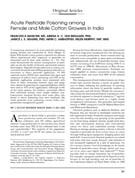 |
A season-long assessment of acute pesticide poisoning among farmers in three villages in India
(Int. J. Occup. Environ Health, 2005 July-Sept:11(3):221-32. Acute pesticide poisoning among female and male cotton growers in India.
Mancini, F., Van Bruggen, A.H., Jiggins, J.L., Ambatipudi, A.C., Murphy, H.)
A season-long assessment of acute pesticide poisoning among farmers was conducted in three villages in India.
The study documented the serious consequences of pesticide use for the health of farmers, particularly women field helpers. |
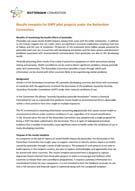 |
Results template for SHPF pilot projects under the Rotterdam Convention
(Secretariat of the Rotterdam Convention, 2010)
This results template is designed to capture important lessons learned from health surveillance projects. Its purpose is to generate a body of information from different projects that can be used to encourage and facilitate other countries to initiate their own surveillance programmes in relation to pesticide use. It requests summary information in a standardised format for easy comparison. |
3. Risk assessment
 |
Health Risk Assessment Toolkit: Chemical Hazards
(WHO, 2010)
The Toolkit provides users with guidance to acquire and use the information needed to assess chemical hazards, exposures and the corresponding health risks. It contains road maps for conducting a human health risk assessment, identifies information that must be gathered to complete an assessment and lists electronic links to international resources from which the user can obtain the necessary information and methodologies. The Toolkit is applicable to pesticides and includes a pesticide case study. |
4. Advocating for action on pesticide poisoning
 |
What is pesticide poisoning?
(Secretariat of the Rotterdam Convention, 2010)
This short leaflet identifies the reasons for monitoring health impacts of pesticides and briefly outlines steps towards developing a monitoring programme. |
 |
Childhood Pesticide Poisoning: Information for Advocacy and Action
(FAO/UNEP/WHO, 2004)
Pesticide poisoning is a serious health problem that disproportionately affects infants and children. The purpose of this document is to provide you with information for advocacy and action directed at reducing pesticide poisoning and addressing its effects on children and women. |
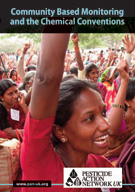 |
Community based Monitoring and Chemicals Conventions
(Pesticide Action Network, 2010)
Evidence of pesticide impacts can help governments to improve national pesticide regulation and help shape international instruments and policies for pesticide control.
Community monitoring is a locally-based process of documenting the effects of pesticides. Through the process of documenting pesticide exposure and impacts, communities become more aware of the risks, a first step toward adopting more ecological and sustainable agricultural practices and reducing their dependence on pesticides. |
5. Promoting safer use of pesticides
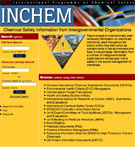 |
International Chemical Safety Cards
(World Health Organization and International Labour Organization)
International Chemical Safety Cards (ICSCs) provide essential health and safety information on chemicals to promote their safe use. They are used at the “shop floor” level by workers and employers in a range of settings including in agriculture.
(www.inchem.org) |
6. Treatment of pesticide poisoning
7. The Rotterdam Convention
Additional resources on other aspects of the Rotterdam Convention are available from http://www.pic.int.
8. Further reading
 |
Reading list 1: institutions
A list of institutions and organisations that are in some way involved in looking at the impacts of pesticides on health, along with a brief description of the organisation and its objectives, the resources they make available and web links.
|